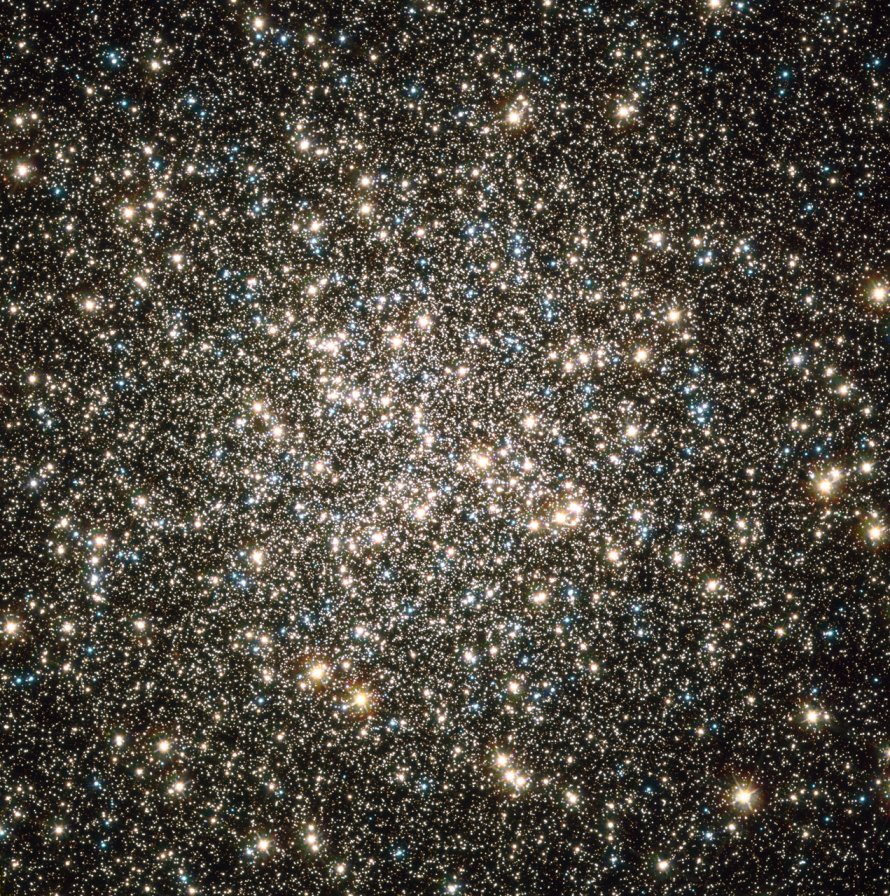M13 (NGC 6205) - Hercules Cluster
Messier 13 (NGC 6205), also known as the Hercules Cluster, is a globular cluster located in the constellation Hercules, in the Galactic Center of the Milky Way Galaxy in the Local Group of galaxies. M13 is 22000 light years away from Earth.
M13 is best viewed during mid-summer, is magnitude 5.8, and can be viewed with naked eye (barely). M13 is 20' in apparent size. For reference, the full moon is 30'.
Observing difficulty: Easiest
- Name:
- Hercules Cluster
- Type:
- globular cluster
- Constellation:
- Hercules
- NGC or IC:
- NGC 6205
- Magnitude:
- 5.8
- Viewing:
- naked eye (barely)
- Size:
- 20'
- Distance (light years):
- 22000 LY
- RA:
- 16h 41.7m
- Dec:
- 36 28'
- Season:
- mid-summer
- Milky Way location:
- Galactic Center
- Galaxy group:
- Local Group
- Messier Marathon #:
- 69
- Contains:
- 300,000 stars
* The naked eye can see up to magnitude ~7-8 objects under ideal dark sky conditions.
The Great Globular Cluster in Hercules
Regarded as a treasure trove for amateur astronomers, Messier 13 (M13), colloquially known as the Great Globular Cluster in Hercules, is an astronomical marvel that encapsulates the ancient splendor of the cosmos. Located in the constellation Hercules, M13 offers viewers an unforgettable stargazing experience. In this article, we will explore its discovery, physical properties, stellar constituents, its brightness, and tips on locating and observing this magnificent celestial object.
Discovery and General Observation
M13 was first discovered by the English astronomer Edmond Halley in 1714 and later cataloged by Charles Messier in 1764. Situated approximately 25,000 light-years away from Earth, M13 is visible to the naked eye under favorable conditions and can be strikingly viewed with modest amateur equipment. With its high concentration of stars, it stands as one of the most prominent globular clusters in the Northern Hemisphere.
Physical Characteristics and Magnitude
The Great Globular Cluster spans about 145 light-years in diameter and hosts several hundred thousand stars, which contribute to its impressive apparent magnitude of 5.8. This bright magnitude makes it one of the most accessible globular clusters for backyard astronomers. With a telescope, M13 transforms from a fuzzy point of light to a breathtaking spherical collection of stars.
Stellar Composition
As an ancient globular cluster, M13's stars are almost exclusively old, low-mass stars. Its age is estimated to be around 11.65 billion years, a testament to the early epochs of star formation. Predominantly, the cluster comprises Population II stars, characterized by low metallicity, a tell-tale sign of their primordial origins. The most common stars in M13 are red giants and horizontal branch stars, although a variety of other evolved stars can also be observed.
Astronomical Significance
The massive concentration of stars in M13 and its relative proximity to Earth make it an invaluable asset for the study of stellar evolution, dynamics of star clusters, and galactic chemical evolution. Moreover, M13's age and composition provide a unique window into the conditions of the early universe, enhancing our understanding of the cosmos' history and development.
Finding and Viewing M13
For amateur astronomers, finding M13 is relatively straightforward. It is located in the constellation Hercules, in the western section of an asterism known as the Keystone. With binoculars or a small telescope, M13 appears as a hazy spot of light. However, with larger telescopes, observers can resolve individual stars, particularly on the cluster's outskirts. The best time to observe M13 is during the summer months when Hercules is high in the sky.



